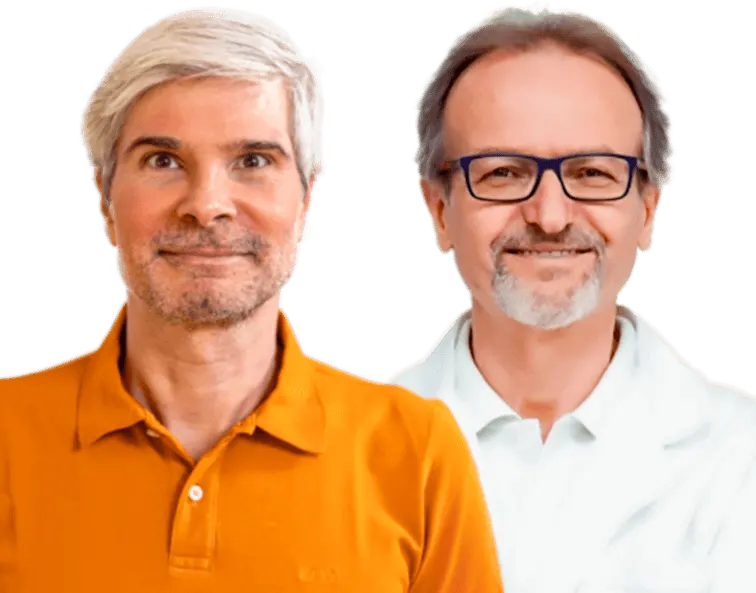Cervical Lordosis Straightening: The Explanation You Never Get
A healthy spine has three curves that provide it with strength and flexibility. Alterations in these curves, whether reduced or excessively emphasized, can trigger various disorders that negatively affect the entire body. Specifically, the cervical lordosis is the curvature located in the upper part of the spine.
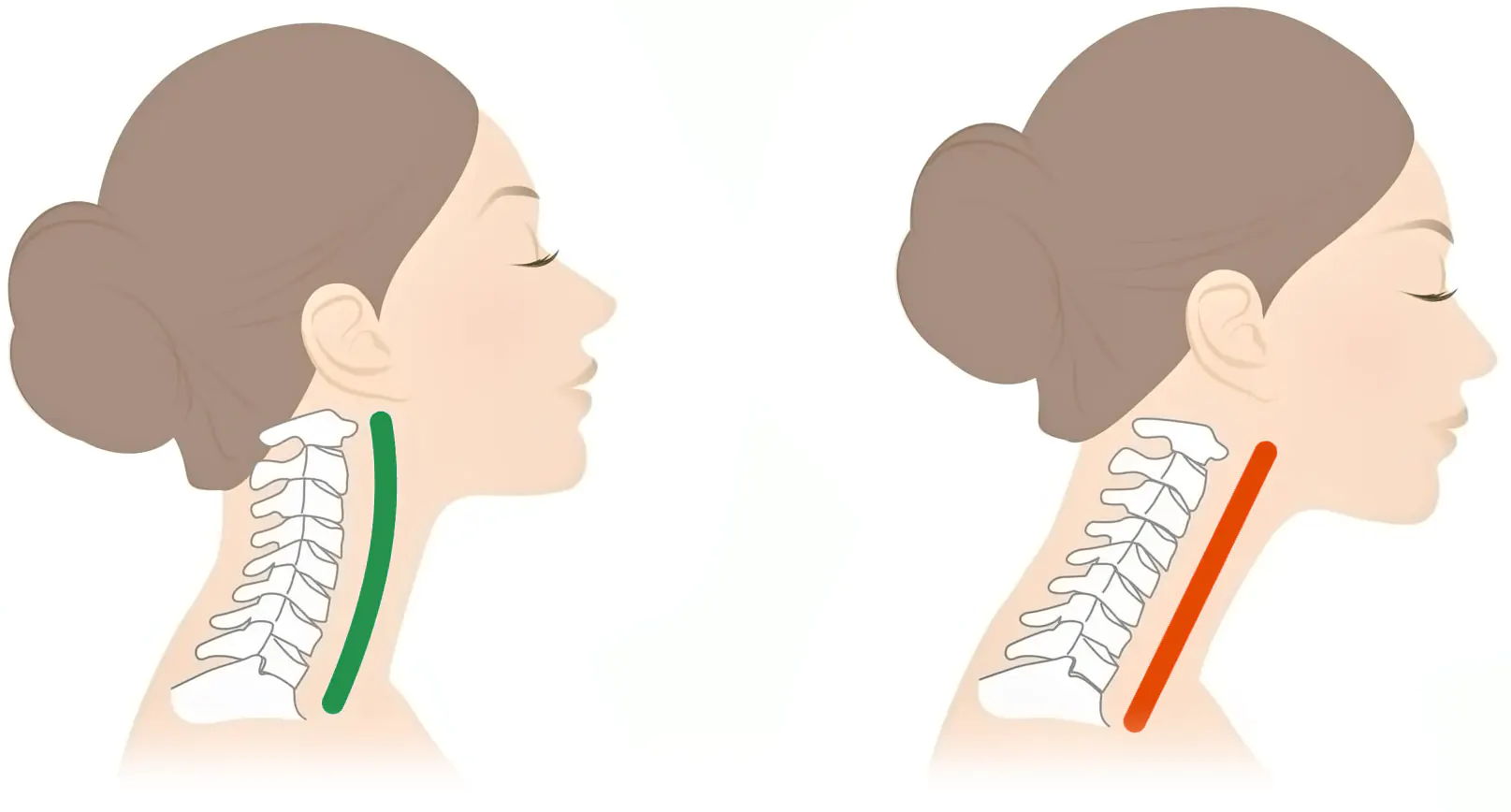
In the field of health, many focus solely on alleviating pain, forgetting that pain is merely a signal of a deeper dysfunction. Treating only the pain is like covering a large, bleeding wound with a bandage, falsely believing the problem is resolved. In reality, it is essential to investigate and address the underlying causes to ensure a lasting solution.
We want to help you become aware and offer you a radically different approach: solving the problem at its root by restoring a healthy and physiological cervical curve. This is essential for the proper functioning of the entire spine and will naturally lead to the disappearance of pain.
What is cervical spine straightening?
Cervical spine straightening, also known as cervical lordosis rectification, loss of cervical lordosis, loss of physiological lordosis, or cervical verticalization, describes a condition where the neck appears excessively straight, losing its natural physiological curve.
Cervical spine straightening and the Atlas vertebra
Cervical spine straightening and a misaligned Atlas vertebra are closely related topics. While other sections of the site analyze the causes and effects of Atlas misalignment on posture, here we focus on the consequences of having an excessively straight neck or one with an inverted curve compared to its natural physiology and how to solve this problem.
A misaligned Atlas can exert abnormal pressure on nerves and blood vessels around the displaced vertebra. If the Atlas is positioned excessively forward on both sides, the underlying vertebrae will tend to follow this movement, causing cervical spine straightening. This condition has even more severe consequences than those caused by a simple rotation of the Atlas. Both types of misalignment can overlap, meaning the Atlas can be globally shifted too far forward from its ideal physiological position, while also being rotated around its axis or laterally displaced.
The relationship between the position of the Atlas and the neck's curvature is strictly bidirectional: if the neck becomes excessively straight due to underlying imbalances, this will inevitably lead to a static forward displacement of the first vertebra; similarly, if the Atlas is anteriorized, it will influence the neck’s shape, making it straighter. These two problems develop in tandem and tend to occur together. In other words, a change in the position of the Atlas often coincides with a change in the neck’s natural curvature, and vice versa. This interdependence highlights the importance of considering both the position of the Atlas and the overall configuration of the neck for an effective and lasting approach.
An anteriorized Atlas can cause bilateral compression of the jugular vein, drastically reducing vascular drainage. Since venous flow also represents the main pathway for cerebrospinal fluid drainage, such compression can trigger a chain reaction with negative repercussions on various fronts, including neurological aspects.
Cerebrospinal fluid circulates around the brain and spinal cord, performing essential functions such as mechanical protection from external stresses and the removal of metabolic waste products. Any obstacle to its normal flow can lead to increased intracranial pressure and reduced toxin elimination, with potential negative impacts on the central nervous system. You can learn more here: Effects on cerebrospinal fluid.
We should not be surprised to experience headaches, migraines, dizziness, and many other disorders if blood cannot flow freely from the cranial cavity, preventing the proper elimination of waste products!
Yet, medicine speaks of incurable neurological diseases instead of acknowledging that, over time, the brain becomes a kind of dumping ground. If we compare the cranial box to an aquarium, medicine insists on administering chemical substances to the fish, yet lets them swim in their own excrement instead of choosing the simplest and most logical solution: changing the water!
Transient to permanent
To fully understand the problem, it is essential to grasp the difference between a temporary and a permanent condition. A condition that persists PERMANENTLY has a significantly different impact compared to a TRANSIENT event.
When the neck is flexed, the muscles exert temporary pressure on the nerves and surrounding blood vessels. This type of stress is generally tolerated without negative consequences, as it is dynamic, variable, and short-lived. As soon as the neck returns to a neutral position, the pressure stops.
In contrast, if the cervical posture at rest deviates permanently from the ideal, the pressure becomes constant and ends up altering the flow of bodily fluids and nerve signals (vagal disorders). In such circumstances, the body tries to adapt by establishing a new balance. However, this adaptation can have various, often negative, consequences on the body's overall balance and function.
List of disorders and symptoms from cervical straightening
If the process of cervical lordosis loss persists for a long time without appropriate corrective intervention, it is highly likely that the cervical spine will become straightened or even inverted.
Here are some of the consequences:

- head heaviness
- cervical headache
- visual disturbances not caused by other conditions
- neck and shoulder pain/stiffness – muscle weakness
- sensation of a lump in the throat and swallowing difficulties
- dizziness and instability
- vagal disorders
- tinnitus
- jaw deviation with bruxism and pain
- cervical disc disease – tingling, numbness in the arms
- cervical spine degeneration and arthritis
- narrowing of the spinal canal (foraminal stenosis)
- formation of osteophytes
- deforming spondylosis – cervical spondylolisthesis
- back pain – chronic muscle tension
What causes the loss of cervical lordosis?
The loss of cervical lordosis occurs due to an imbalance between the anterior and posterior muscle chains of the spine, sometimes associated with ligament laxity in certain vertebral segments. It is often an adaptive response to misalignment, imbalance, or localized damage either upstream (in the upper part) or downstream (in the lower part) of the spine. The cervical spine is inseparably linked to the movement of the dorsal and lumbar regions, and vice versa. This implies that any alteration or imbalance in one area can directly affect the others. For example, a problem in the lumbar region can trigger an ascending chain reaction that leads to a change in cervical curvature. Similar interdependencies can manifest in other directions as well.
The cause of neck straightening can be multifactorial, meaning several triggering or aggravating factors can coexist and contribute to the condition. These factors must be examined individually and, if present, corrected before the physiological curvature of the cervical spine can be restored.
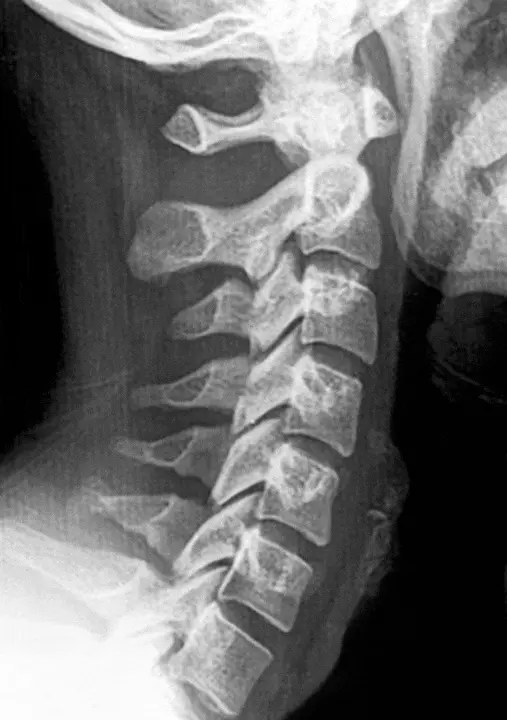
As shown in the following animations, when the cervical spine is straightened, the Atlas is constantly in an overly advanced position, similar to the one normally assumed when tilting the head forward and pulling the chin toward the chest. This is a transient position that becomes permanent. This state causes abnormal and constant pressure on the internal structures of the neck.
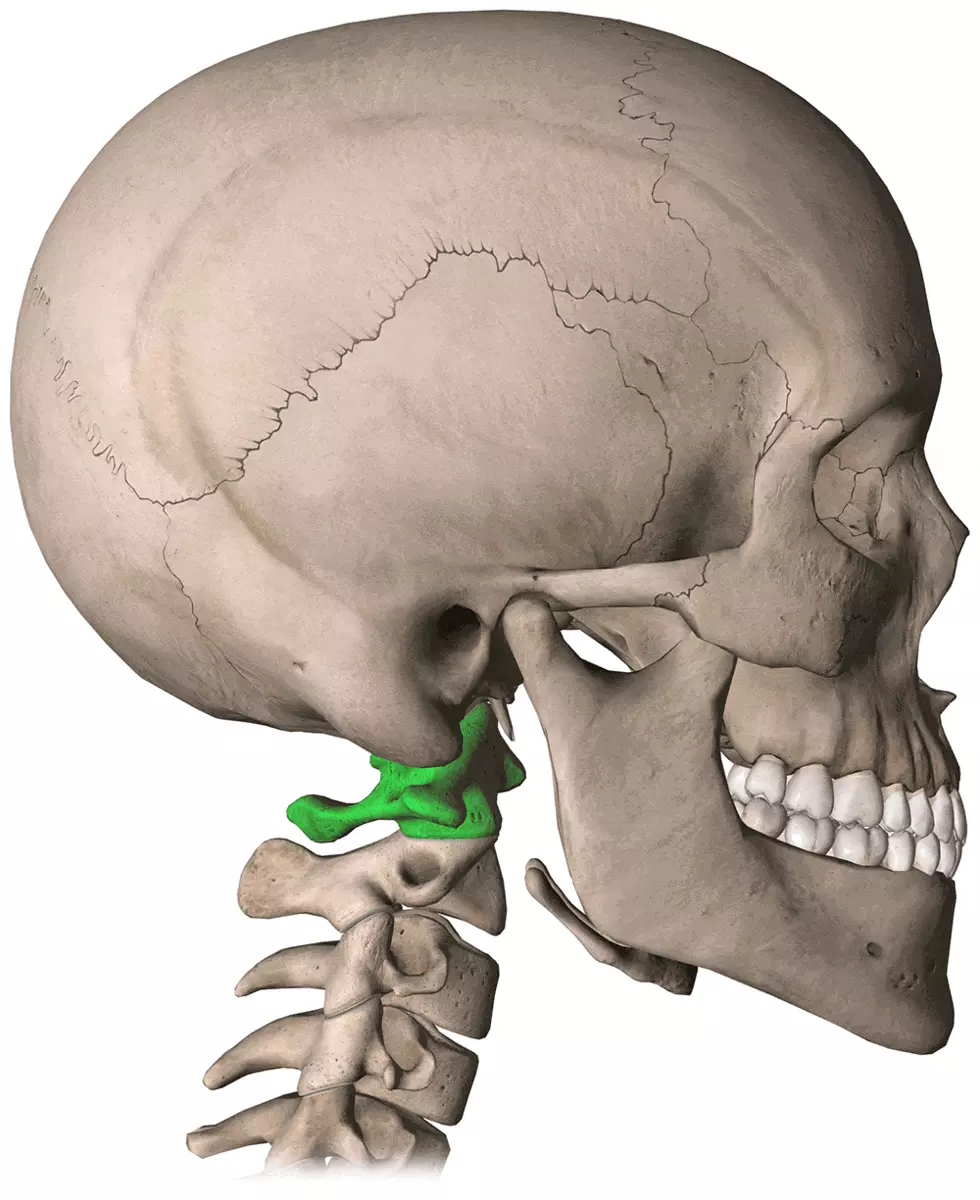
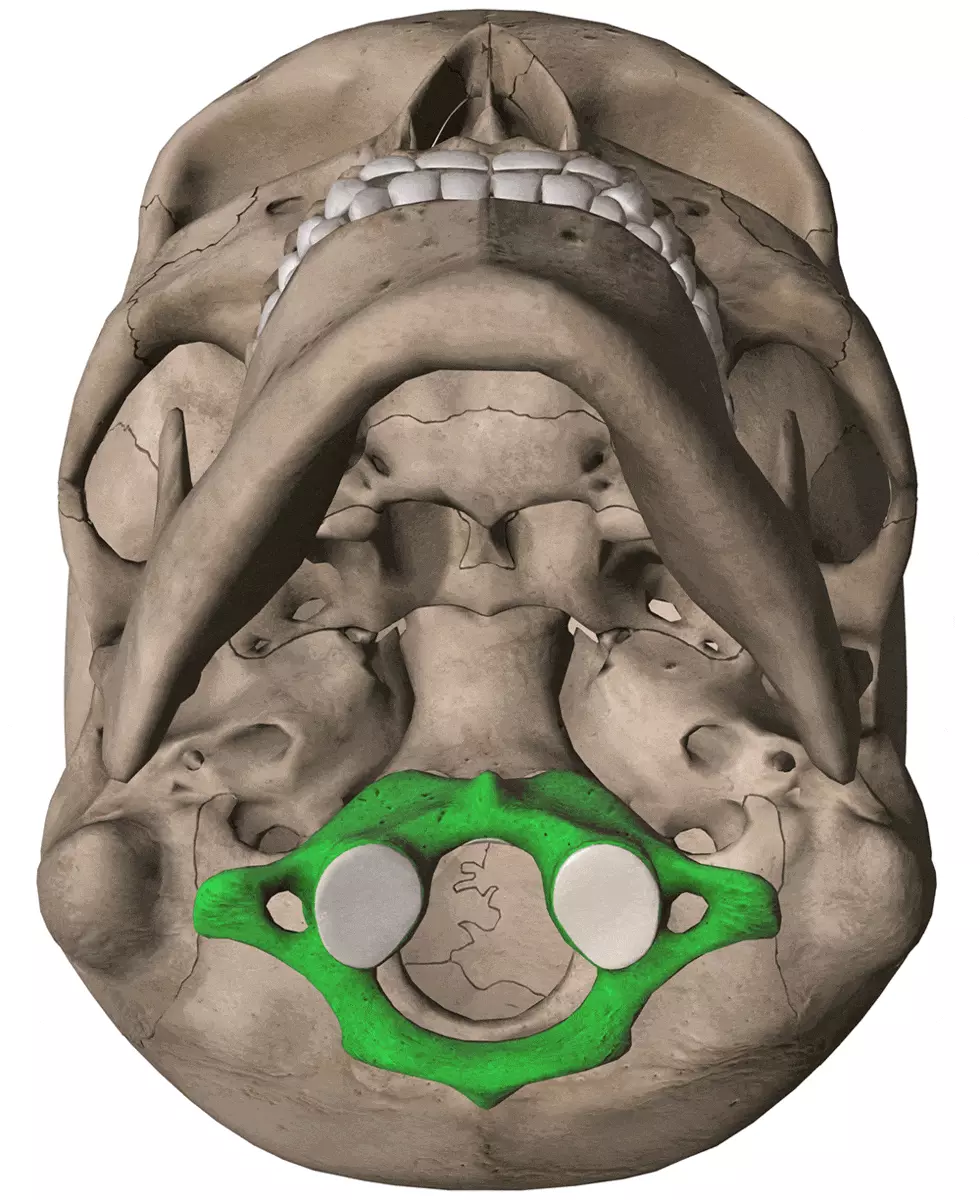
Loss of cervical lordosis and jaw
If jaw problems are also present, such as a deep bite and thus a receded jaw, the situation worsens due to the backward pressure exerted by the mandibular condyle, which compresses the temporomandibular joint. Over time, this joint degenerates, not to mention the damage it causes to the surrounding structures.
The height of the teeth (vertical dimension of dental occlusion) determines the spatial position of the jaw in relation to the skull. Therefore, to permanently correct the receded jaw position, it is crucial to restore proper dental occlusion, ensuring that the height of the dental arches is adequate. Treatments focused solely on muscles can offer only symptomatic and temporary relief. Without adjusting the occlusion and the height of the dental arches, the problem tends to persist.
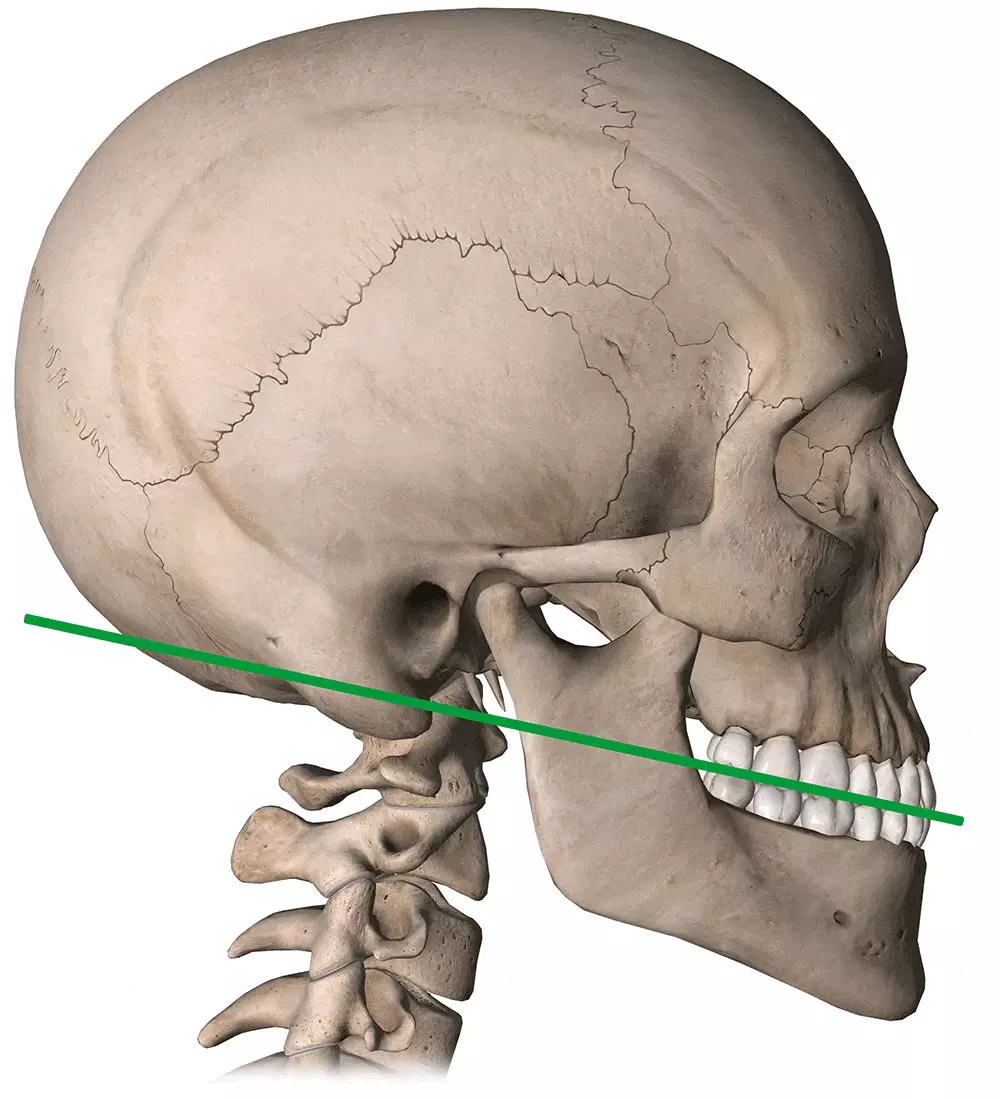
How does cervical lordosis loss occur?
There are two main causes:
- It develops progressively over time due to poor postural habits.
- It occurs following traumatic events such as whiplash, a fall, or intubation during surgery under general anesthesia.
Cases of cervical lordosis loss are increasing significantly, suggesting that new and widespread harmful postural habits have emerged in recent years.
Nowadays, it has become normal to spend many hours in front of laptop and smartphone screens. This practice has become so widespread that it is now the main cause of the increase in cases of cervical straightening and a host of other related medical problems. The incorrect posture induced by prolonged use of devices, with the neck tilted forward and downward, contributes to the loss of the natural curvature of the cervical spine, leading to negative repercussions on overall health.

The term "tech neck" describes the damage that can occur in the neck, spine, and overall posture due to the habit of staring at a screen for extended periods while keeping the neck bent forward.
Not only can visual acuity deteriorate significantly, benefiting sellers of glasses and contact lenses who have seen their market expand, but the cervical structure also suffers consequences from keeping the neck bent forward and downward for many hours a day.
The resulting myopia and other visual impairments further exacerbate the situation, creating a vicious cycle: visual deficits lead to compensatory behavior, such as tilting and bringing the head closer to the screen to see better, thereby worsening posture even more.
Although moderate use of computers and phones does not necessarily cause negative effects, it is essential to maintain good posture during use. The cumulative effect of spending many hours in front of a screen every day can indeed be harmful, increasing the likelihood of losing the proper curvature of the cervical spine. The recent spread of remote work has further worsened the problem, as many people spend even more time sitting and leaning over their devices in home environments, often less ergonomic than traditional offices.
If you cannot avoid looking at a screen for many hours a day, it is important to take measures to minimize the negative impact on posture. It is advisable to position the screen at eye level, avoiding tilting the neck and head forward. Working on a laptop placed directly on the table forces the neck into a non-optimal position. Ideally, you should use an appropriately sized external monitor positioned at a height and distance that allows for an upright and relaxed posture. Also, try to minimize activities performed on your phone.
Get into the habit of holding your smartphone at eye level instead of tilting your head to look at it. When working on a computer, position the bottom of the monitor at or above eye level. If you use a laptop, you can invest in a wireless keyboard or connect a second monitor to avoid having to look down.
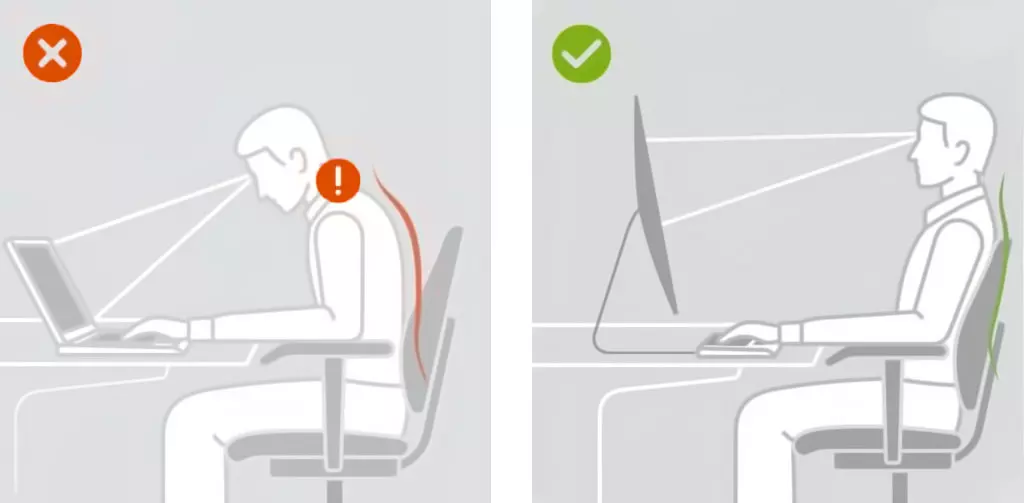
A phone, tablet, or laptop without an adequate external monitor is fine for occasional use throughout the day but not for working or, worse, for gaming for many hours a day. After several years of poor posture, with the head constantly tilted downward, both vision and the neck will inevitably suffer severe consequences.
If you think you are saving money by opting for small, low-cost displays unsuitable for prolonged use, consider how much you will have to spend on your health when your neck degenerates, becoming a source of concern and chronic pain.
This is the harsh reality of today:
A sedentary lifestyle contradicts the dynamic nature of the spine. Spending long periods without moving stiffens the musculoskeletal system. This stiffness causes muscle soreness, interferes with proper blood circulation, and increases the risk of injury.
If you have an office job that requires you to spend long hours sitting and looking at a monitor, it is very important to take breaks to stand up, move, and stretch. Regular physical activity outside of work is equally important to keep the body active and flexible, improving overall health and well-being.
Your future health heavily depends on these simple but fundamental habits. You can find countless videos online with office stretching exercises.
Children, computers, and mobile phones
Among young people, spinal problems are becoming increasingly endemic. Instead of engaging in outdoor activities, many spend their time in front of a screen, which hinders the harmonious development of the body and muscles through healthy physical exercise.
This trend significantly contributes to both physical and mental weakness. We are raising a generation of weak individuals suffering from serious health problems. If we add a poor diet rich in sugar and energy drinks, we are preparing for a generation of zombies, devoid of vitality and motivation, unable to face life's challenges. What are parents doing to prevent this?
What are the long-term consequences of cervical lordosis loss?
While a temporary loss of cervical lordosis may be tolerated without immediate consequences, the long-term effects of this condition can be detrimental to the entire musculoskeletal system, including the intervertebral discs. Living for extended periods with a flattened or even inverted neck curvature leads to structural and functional changes in the ligaments, vertebrae, and intervertebral discs. These structures have a certain plasticity, meaning that if subjected to constant pressure, they can change their structure and deform.
While muscles can contract or stretch and then return to their original shape without significant changes or permanent damage, changes involving ligaments and intervertebral discs require much longer periods and specific interventions to be reconditioned. For this reason, it is generally easier to restore cervical lordosis in a young individual who has not lived for years with poor posture.
Spinal discs require regular movement to remain healthy. When the natural curvature of the neck is altered, the movement of the spinal segments is also affected. This leads to abnormal, constant pressure distribution on the discs, causing their gradual loss of volume. As a result, some spinal segments stop moving properly, while others become hypermobile, compromising joint stability. This imbalance, combined with increased load and reduced mobility, accelerates disc degeneration.
The spine becomes weaker and more vulnerable when it loses the curves that provide it with strength and flexibility. People who have lost the physiological lordosis of the neck are more prone to serious injuries in the event of trauma, such as car accidents, falls from great heights, or blows to the head with heavy objects. In these scenarios, a spine without its natural curves is less efficient at properly distributing mechanical forces, making the individual more susceptible to damage.
The physiological curvature of the cervical spine plays a crucial role in maintaining the structural and functional integrity of the neck. The loss of this curvature can result in mechanical stress on the facet joints and intervertebral discs increasing by five to ten times the normal level. This increased load per unit of surface area can accelerate their deterioration, leading to cervical spine degeneration. This degenerative process causes a variety of disabling symptoms that are rarely attributed to the lack of cervical curvature. Understanding this mechanism highlights the importance of prevention to maintain spinal health.
When the natural curvature of the neck, which helps evenly distribute the weight of the head, is reduced or lost, the neck and shoulder muscles must compensate with greater effort to support the head. This overload can lead to muscle tension and pain, with an increased risk of developing chronic muscle contractures. These contractures not only limit movement and intensify pain but also increase pressure on the intervertebral discs. This added pressure accelerates disc degeneration, triggering a cycle of pain and spinal deterioration that can significantly affect quality of life.
When an intervertebral disc ruptures after prolonged degeneration caused by constant uneven pressure, the disc can protrude into the spinal canal from which nerves emerge, causing pain and numbness that radiates to the arms or legs in the case of lumbar disc herniation.
There is a widespread belief that cervical disc herniations are caused by lifting heavy weights or intense physical activities. However, living for years with a straightened spine is much more decisive.
If we compare vertebrae to two slices of bread and the intervertebral disc to mayonnaise between them, excessive pressure on this "sandwich" would cause the mayonnaise to spill out. Medicine, with a short-sighted view, would blame the mayonnaise for the stains rather than recognizing excessive pressure as the true cause. This example illustrates a common paradigm: what is actually a victim of circumstances is often mistakenly perceived as responsible for the problem.
An often underestimated and difficult concept for many to grasp is the following: a compromised ideal posture and the resulting permanent imbalance lead some skeletal bones to position themselves improperly. This misalignment not only limits proper bone movement but also exerts constant pressure on surrounding soft tissues. Imbalanced muscle chains become rigid and hypertonic, further applying abnormal and continuous pressure on adjacent tissues, including nerves, lymphatic vessels, and blood vessels. This situation creates a vicious cycle of dysfunctions that exacerbate each other, complicating the clinical picture.
Where there was once enough space for the harmonious coexistence of various anatomical structures, some are now confined to restricted areas, a particularly critical situation for sensitive tissues such as nerves and blood vessels. The normal flow of body fluids is slowed, with all the consequences you can imagine. In this condition, the body cannot function properly and develops symptoms and disorders. The most rational and effective solution is to restore adequate spaces, regain a posture closer to the ideal, and reduce muscle contractures.
The problem is conceptually simple: it is about restoring order, ensuring that each element is in its rightful place. In the human body, as in other aspects of life, difficulties arise when one element encroaches on the space of another. This represents the BEGINNING of the problem and is also the point that needs to be corrected. However, attention often focuses on the AFTER, that is, mitigating the effects rather than addressing the root cause, the BEFORE. The initial situation, where the invasion of vital space begins, is overlooked, even though it is the key moment from which everything stems.
Therefore, addressing the root problem becomes essential; without this, a definitive solution remains out of reach. We should not be surprised if the body starts malfunctioning when its supply routes are compressed at multiple points and nerve signals are altered. The real surprise lies in how some bodies manage to function reasonably well despite these adverse conditions. This remarkable adaptability reflects the resilience of the human body but also underscores the importance of identifying and correcting the primary causes of disorders rather than merely treating the resulting symptoms. Prevention is too often neglected, and people try to take action when it is already too late.
The metaphor of stepping on a water hose effectively illustrates how a constant blockage can compromise the proper functioning of a system. If you step on the hose every time you water the garden, do not be surprised if your garden dries up. Similarly, many people are unaware that poor posture limits their "vital circulation," whether it is blood flow, nerve transmission, or other essential physiological processes. Instead of identifying and removing the obstacle—"taking the foot off the hose"—they apply inadequate solutions suggested by doctors, which not only fail to solve the problem but often exacerbate it. This analogy highlights the importance of the affected person understanding the real causes of their problem to consciously choose therapeutic approaches aimed at resolving the disorder rather than just managing its symptoms.
Inverted cervical curve
An even more serious condition than an overly straight neck is an inverted neck curve. It is important to understand that symptoms may intensify during the process of restoring an inverted curve. This apparent worsening may mistakenly lead one to believe that the situation is deteriorating further, prompting them to discontinue measures taken to address the inversion. This phenomenon occurs because the cervical spine must go through a critical phase where it becomes straight again before it can curve forward and regain its natural physiological curvature. During this transitional phase, the spine is more extended and subjected to greater tension, which can heighten perceived symptoms.
In the process of correcting an inverted neck curve, it is inevitable to go through this intermediate phase. This process is comparable to that of an internal combustion engine, where the piston must reach the top dead center to allow the connecting rod to descend on the other side of the crankshaft.
A straight neck is longer than a curved neck
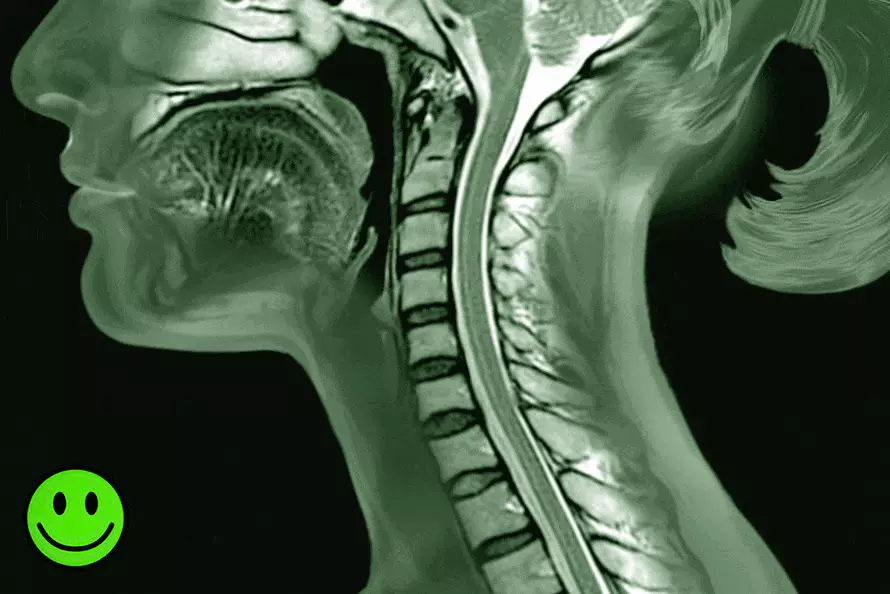
A straight neck appears "longer" than the same neck with a normal lordotic curve. You can easily verify this yourself: take a piece of string and stretch it with your fingers. If you move your hands closer together, the string bends and the distance shortens; if you move your hands apart, the string stretches and the distance increases. The same happens to the neck when the cervical spine straightens. When the neck is longer, the brain is constantly pulled downward, and the blood vessels and nerves are subjected to the same continuous tension. It seems that this aspect is not considered by doctors, despite being a basic principle of mechanics. One could hypothesize that the Arnold-Chiari malformation (where the cerebellum sinks into the spinal canal) and the Eagle syndrome (elongation/calcification of the styloid process) could be one of the consequences or at least worsened by the straightening of the cervical spine.
What does the doctor do in these cases?
In the medical field, cervical straightening is often observed passively rather than addressed effectively at its early stages until it becomes irreversibly too late. Beyond diagnosis and efforts to alleviate related symptoms, concrete measures to restore the physiological lordosis are rarely implemented. It is not even communicated that the failure to restore lordosis inevitably leads to irreversible degeneration of the neck structures. This silence might be due to the absence of concrete solutions within the medical field to correct a straight cervical spine or the position of the Atlas vertebra, as there are obviously no medications to solve mechanical problems. As a result, the problem tends to be simply IGNORED.
You might be told that cervical straightening is common and not a significant cause for concern. The same, somewhat absurd, statement is also made regarding a misaligned Atlas: according to medicine, it should not be a major concern, even though in practice, effective correction with AtlantoMed often resolves numerous symptoms that medications cannot address.
The proposed solutions to manage the consequences of cervical straightening often include prescribing an anti-inflammatory to relieve discomfort, a painkiller for headaches if present, and perhaps another medication for dizziness, continuing in this manner for all other symptoms. You may be prescribed physiotherapy, although it has never been observed that this practice restores the cervical curve. You might be advised to engage in sports and manage stress, which is often vague and challenging to implement. It is not uncommon for symptoms to be attributed to psychological factors or anxiety, especially when no clear explanation or solution is found for the problems presented, which is typical whenever doctors fail to effectively resolve an issue. This approach is comparable to ignoring incorrect wheel alignment on a car, suggesting that you continue driving without worrying too much about the inevitable asymmetrical and premature tire wear, demonstrating a certain resignation to the situation. This attitude might stem from frustration over the lack of definitive therapeutic options included in traditional medical training.
Shall we discuss the misleading advertising allowed only in Italy? The advertisement for a well-known drug claims: "Cervical headache arises from inflammation of the musculoskeletal system, causing persistent pain from the neck to the head". The entire issue is blamed on inflammation, which is actually only the CONSEQUENCE of the problem, not the CAUSE. Indeed, if the advertisement revealed the true origin of the problem and suggested a method to resolve it definitively, it might not be as effective in promoting drug sales. This raises important questions about the role of advertising in healthcare and the transparency of information provided to consumers about their condition and available treatment options. In Switzerland, for example, drug advertising is strictly prohibited, an approach that aims to better protect citizens from potentially misleading messages solely designed to increase sales.
For many disorders, including cervical straightening, medicine ignores the causes and lacks a true solution. Eventually, when the cervical spine is irreparably compromised, the doctor will suggest surgery. If you are wise, you will take resolute action as soon as possible if your neck is straightened, turning to those who offer REAL solutions without waiting until it is too late and without being influenced by the doctor's harmful reassurances or misleading advertisements. This advice also applies to other disorders you might have.
Cervical surgery and spine straightening
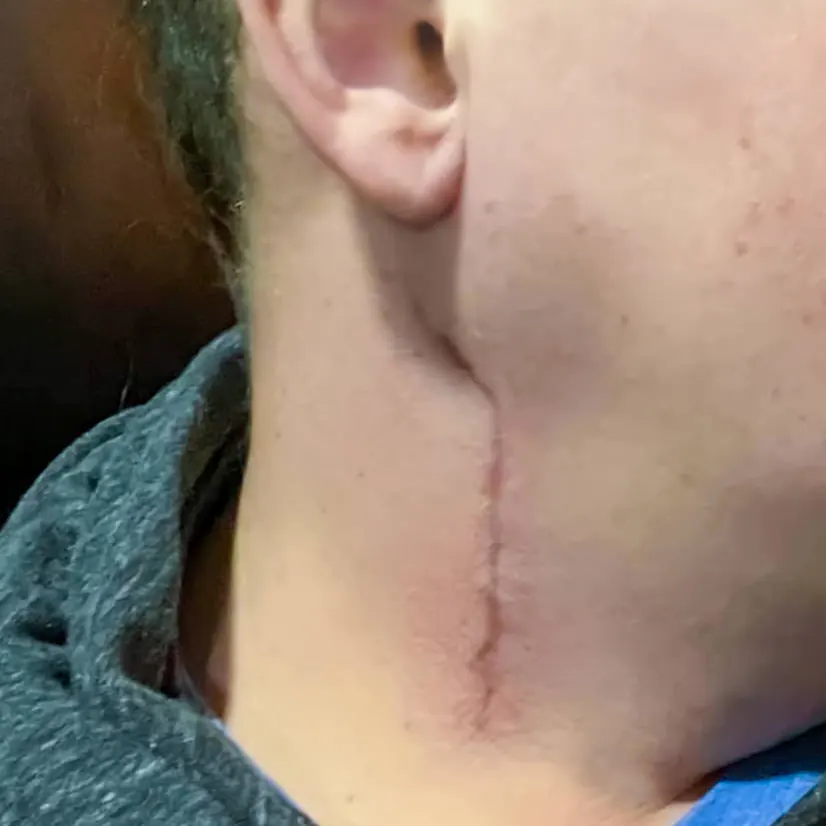
There is a saying: "When the only tool you have is a hammer, every problem looks like a nail". In the context of surgery, this hammer becomes the scalpel used to remove what is considered superfluous and deemed the supposed cause of your problem. There are some "characters", especially overseas, who have had the strange idea of relieving the pressure caused by incorrect cervical or mandibular alignment by removing bone parts to create more space, such as the styloid process or the protruding portions of misaligned vertebrae, rather than simply restoring proper cervical alignment.
The issue of a neck becoming too straight, the omnipresent misalignment of C1, C2, and the receded jaw are ignored or underestimated. Using the scalpel proves to be much more profitable. It is now widely known that the chisel is often misused with the far-from-noble intent of making money. Properly studying and informing oneself about health has become a true act of self-defense. This is also why, on this site, we strive to explain various topics in detail. A real understanding helps avoid being deceived.
What does a manual therapist do when they encounter a straight neck?
A physiotherapist can adopt various approaches to alleviate pain and discomfort caused by a straightened cervical spine:
Manual therapy: The physiotherapist may use techniques to stretch and relax the neck and back muscles. This can help reduce muscle tension and improve flexibility.
Joint mobilization: This technique aims to improve joint mobility. The physiotherapist applies controlled and gradual force to move the cervical spine joints to their natural position.
Spinal manipulation: It involves applying a quick and precise thrust to "unlock" the cervical spine joints. Although it may relieve pain and stiffness, this technique is used only after a thorough evaluation, as it carries some risks.
Instrument-assisted massage: Devices are used to massage tissues, reduce muscle contractions, and improve blood circulation.
Myofascial therapy: This technique applies targeted pressure on muscle trigger points to alleviate pain and stiffness. Myofascial therapy can be combined with other manual therapy techniques.
Stretching exercises: The therapist may prescribe specific stretching exercises for the neck and back muscles to improve flexibility and mobility. One common exercise involves gently tilting the head to one side and holding the position for about 20 seconds, then repeating on the other side. Another exercise involves tilting the head backward and holding that position for a few seconds before slowly lowering the head.
Strengthening exercises: These are used by physiotherapists to strengthen the neck and back muscles, prevent further damage to the cervical spine, and improve posture. It is important to perform these exercises correctly to avoid further cervical spine damage. The physiotherapist may provide detailed instructions on the movements and frequency of the exercises based on the patient's needs.
Electrical stimulation: A device sends electrical impulses to the muscles to produce rhythmic, involuntary muscle contractions. It can be used to strengthen weak neck and back muscles and improve posture.
Radiofrequency therapy: This technique uses radiofrequency energy to heat deep tissues and stimulate the body's natural healing process by increasing local blood circulation. It can be used to relieve pain, reduce inflammation, and accelerate the healing of damaged tissues.
Ultrasound therapy: High-frequency ultrasound waves are used to stimulate deep tissues and improve blood circulation. Ultrasound can help reduce inflammation, relieve pain, and enhance muscle flexibility.
Laser therapy: This technique uses a laser beam to reduce inflammation and accelerate the healing of damaged tissues, with an analgesic effect.
Heat and cold therapy: The physiotherapist may use heat or cold to alleviate pain and reduce stiffness. Consider using a sauna as well.
What do all these therapies applied by physiotherapists have in common? They address symptoms rather than the underlying causes that keep the neck in an incorrect position. Although these treatments may be pleasant and are a great complement to mitigate symptoms, it is unlikely that they alone can restore a healthy cervical lordosis, even if temporary pain relief might lead you to believe you are on the right track. While these approaches are definitely better than taking medication, if symptoms persist, remember to reread this page.
CCSVI and cervical straightening
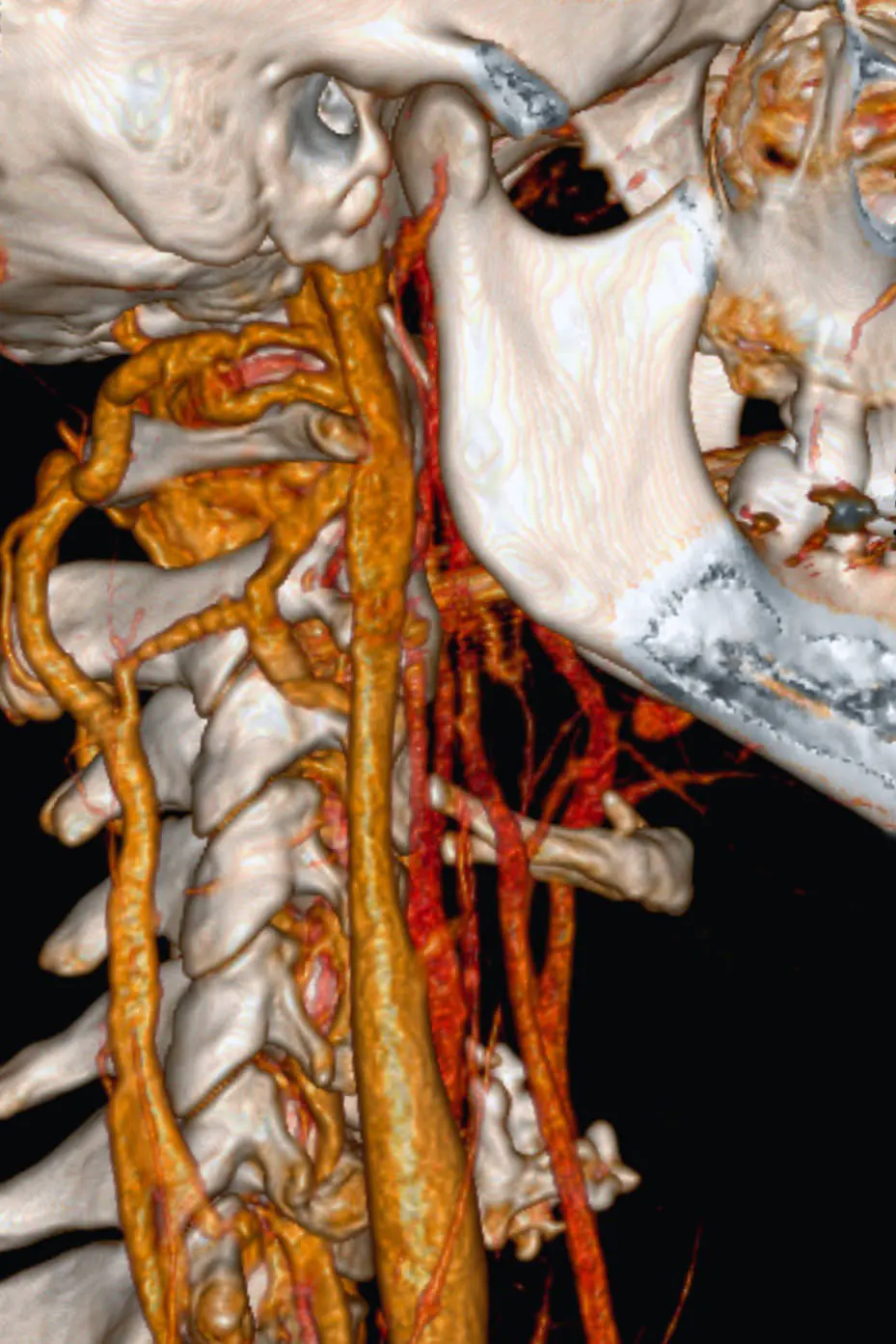
CCSVI (Chronic Cerebrospinal Venous Insufficiency) is a condition characterized by reduced venous flow, which hinders blood drainage from the brain. This, in turn, negatively affects the circulation of cerebrospinal fluid. This phenomenon is associated with a variety of often debilitating symptoms and is thought to contribute to the development or worsening of certain neurological disorders.
CCSVI may result from an internal malformation of the veins, compromising their structure and blood flow, or from constant external compression of the vessels. In some cases, both causes may be present simultaneously, further reducing blood flow.
When investigating CCSVI, it is important not to make the mistake of attributing all stenoses solely to venous malformations.
The misalignment of the first two cervical vertebrae, typically associated with cervical straightening, is one of the most common external causes.
Conditions to verify: Is the neck straightened and too far forward? How are the Atlas and Axis aligned? Is the jaw deviated or retracted? What is the condition of the cervical muscles? Are the sternocleidomastoid and scalene muscles enlarged and hardened? These often-overlooked aspects are fundamental questions for an accurate analysis but are rarely considered.
It is important to know that diagnostic images, such as angiographies and contrast-enhanced MRIs, can be misleading. Veins, with their tortuous paths and natural curves, may show apparent narrowing depending on the angle or plane of observation. Sometimes, what appears to be a stenosis in the images is merely a normal change in the direction of the blood vessel without clinical significance.
A critical analysis may reveal that some doctors or radiologists, due to a lack of specific experience or, in some cases, less noble interests, present the results in a way that favors a particular interpretation. For example, they may manipulate the observation axes or, in the case of a CT scan, adjust the tissue distinction thresholds to obtain a visualization that supports a certain diagnosis, justifying a surgical procedure. This risk is particularly significant in the interpretation of MRIs, especially when the doctor presenting the images has a direct interest in performing surgery.
To avoid errors or conflicts of interest, it is strongly recommended to always seek a second independent opinion when interpreting diagnostic images. Having the images analyzed by a radiologist specializing in CCSVI, who has no professional or personal ties to the first consulted specialist and is unaware of the previous reports, ensures a more objective and impartial evaluation. A second opinion can confirm the initial diagnosis, offer an alternative perspective, or suggest different diagnostic and therapeutic approaches.
Cervical instability after whiplash
Following an accident with whiplash that caused stretching of the joint capsule and/or ligaments, the affected cervical joint may become excessively loose or unstable, meaning the involved vertebrae can move excessively relative to each other, compromising joint stability during movement. This circumstance leads to variable abnormal compressions of the adjacent structures. Prolonged improper cervical postures can also induce tissue adaptation, resulting in ligament and joint capsule elongation, further worsening joint instability.
You can read more about it here: cervical instability
Have your Atlas assessed at an authorized AtlantoMed Center:
How to resolve cervical straightening?
When cervical straightening has been present for a long time, perhaps initially without symptoms, it is unrealistic to expect a quick resolution without significant personal commitment. In most cases, relying on a single treatment is not enough; a structured approach is necessary, involving multiple interventions applied in the correct sequence and with appropriate gradual progression.
Attempting improvised approaches inevitably leads to failure, if not a worsening of symptoms. Since a straightened neck tends to be particularly sensitive, with hypertense and stiff muscles, it is essential to intervene gently and gradually to avoid exacerbating an already fragile condition.
Postponing or neglecting the problem without addressing it promptly and effectively leads to the progressive and inevitable degeneration of the spine, making non-invasive solutions increasingly unlikely until the point of no return is reached, where surgery becomes the only option—with all the negative implications, costs, suffering, and potential complications it entails.
We can affirm that symptomatic therapies, commonly suggested by doctors, act as palliatives. While medications may temporarily mask discomfort, the underlying mechanical problem persists and worsens, leading to increased symptoms. This drives the doctor to prescribe increasingly powerful drugs in an attempt to manage ever-more invasive symptoms.
Procrastinating when you have a straight neck is truly unwise, just as it is to neglect dental care. If you think you're saving money, you'll end up with a much more severe and irreparable problem, accompanied by chronic pain. Does it really make sense to delay action rather than addressing the issue effectively and definitively?
8 steps to restore physiological lordosis
Before delving into the steps necessary to restore the correct cervical lordosis, it is crucial to understand which attitudes can make the difference between success and failure.
Path to success
- Confirm the presence of cervical straightening through an X-ray taken in an upright, unforced position.
- Complete each step listed with determination, without being distracted, discouraged, or giving up when difficulties arise.
- Ensure that the goal of each step is achieved. For example, merely wearing a bite does not mean that the jaw problem has been resolved.
- Verify at the end of the process that the physiological cervical curve has been effectively restored; if not, continue the exercises until the goal is reached.
- Adopt correct postural behaviors to prevent the problem from recurring.
Path to failure
- Many people act without a defined strategy, proceeding randomly and without a clear understanding of their objectives.
-
They fail to understand the difference between purely symptomatic treatment and one that addresses the root cause. As a result, they focus on symptom management and immediate pain relief, neglecting the fundamental aspect of eliminating the cause.
- They passively rely on advice from others, accepting information that is often incomplete, misleading, or contradictory, without dedicating time to thoroughly studying the problem and developing an informed and aware perspective.
- They begin a process without completing it. They do not ensure that a step is ACTUALLY completed before moving on to the next one.
The 8 steps to follow
Some advice
If a real and properly identified cervical instability exists, this becomes the first issue to address and resolve. Prolotherapy can be a valid help in this regard. Otherwise, any other solution risks failure, leading to a waste of time, financial resources, and potentially a worsening of the problem. If the instability involves C1 and C2, the first two cervical vertebrae, we do not recommend proceeding with the correction of the Atlas without first resolving the instability.
If there are mandibular problems and these are not ACTUALLY resolved, relapses are guaranteed. Many will try to persuade you that your occlusal problem has been solved, even when it has not. Check it yourself in front of the mirror: TEST.
The exercises indicated in points 5 or 6 can be performed in parallel with the actions indicated in points 2-3-4. It is important to avoid excessive exercise intensity and instead increase it gradually. An overly intense training approach may worsen symptoms and lead to discouragement. Maintaining a suitable gradient in exercise intensity is essential to ensure steady progress without overloading the neck.
What People Say About Us
Beware of those who disguise a simple cervical manipulation as Atlas realignment and those who offer low-quality imitations of our method. The results speak for themselves: over 10,000 testimonials and reviews in various languages make us unique. Click to discover opinions, ratings, and authentic experiences shared by those who have experienced Atlas correction with Vibro-Resonance AtlantoMed:


